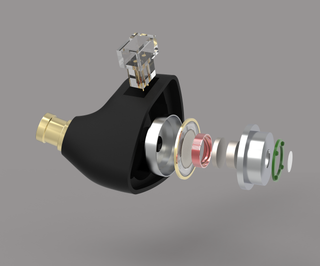Dual Helmholtz resonance systems represent the latest building block in our single dynamic development. Both the Aria Ear Sylva and Azuri showcase how this technology transforms your listening experience, delivering natural treble brilliance without fatigue or harshness.
What is Helmholtz Resonance?
Helmholtz resonance is a fundamental acoustic phenomenon involving air resonance within a cavity system, similar to the sound produced when blowing across a bottle opening. This resonance occurs when air is forced in and out of a cavity, causing the enclosed air to vibrate at a specific natural frequency.
The basic Helmholtz resonator consists of:
- A cavity (main chamber)
- A neck (opening or port)
The size and shape of these elements determine the resonant frequency.
How Dual Helmholtz Systems Work
Unlike single Helmholtz resonators, dual systems employ two resonance chambers working in tandem. Research shows that dual Helmholtz resonators have two distinct resonance frequencies that can be independently tuned.
Key Advantages
- Multiple Frequency Targeting: Each chamber targets different frequencies for broader acoustic control
- Enhanced Attenuation: Superior noise reduction compared to single configurations
- Improved Phase Response: More sophisticated acoustic filtering through resonator interaction
Key Benefits of Dual Helmholtz Technology
- Suppression of Unwanted Resonances: The dual chamber system actively suppresses resonances that mask upper-frequency details. This allows natural music characteristics to emerge without artificial coloration.
- Natural Treble Enhancement: Rather than boosting treble through driver manipulation, the system removes interfering resonances, allowing treble to "shine with natural brilliance". This maintains authenticity while improving clarity.
- Reduced Listening Fatigue: By eliminating harsh resonance peaks, both models deliver crisp, airy sound with "sparkle and openness" without causing ear fatigue.
The Science Behind Performance
Modern research demonstrates that Helmholtz resonators function as acoustic notch filters, removing energy at specific frequencies. The dual configuration provides two independently controllable filters, allowing precise acoustic sculpting across multiple frequency bands.
This passive acoustic approach offers several advantages:
- No electronic components required, reducing complexity
- Minimal phase distortion compared to electronic filters
- Broad bandwidth control through dual chambers
- Long-term stability in mechanical acoustic systems
Implementation in Aria Ear Products
Both the Sylva and Azuri integrate precision-engineered dual Helmholtz resonance chambers tuned at specific frequencies of 5 kHz and 6.2 kHz. This strategic tuning targets critical frequencies where unwanted resonances commonly occur in both internal chamber resonance and driver inner resonance.
In our rigorous evaluation phase, the transformative benefits of the Dual Helmholtz resonator truly shone through, elevating the listening experience to new heights of clarity and immersion. By precisely targeting and attenuating unwanted resonances in the lower treble region—typically that pesky 2-5 kHz band where sibilance and harshness can muddy the waters—this innovative design unleashes a cascade of sonic refinements.
The result? A strikingly more detailed sound profile that breathes life into every frequency band:
- The highs sparkle with crystalline precision
- The midrange gains a lush, textured body that draws you into vocals and instruments
- The bass range deepens with authoritative, articulate punch, free from any veil of distortion
Gone is the fatigue-inducing edge; instead, the overall presentation feels effortlessly smooth and less harsh, allowing intricate nuances—like the subtle decay of a piano string or the whisper of a cymbal—to emerge with vivid realism. But the magic doesn't stop there: the soundstage expands dramatically in both width and depth, painting a holographic panorama that feels expansive and three-dimensional, as if the performers are sharing your space. This enhanced flow fosters an almost tangible sense of rhythm and cohesion, pulling you deeper into the music with an emotional resonance that lingers long after the final note fades. It's not just better sound—it's a gateway to rediscovering the soul of your favorite recordings.
Choosing Between Sylva and Azuri
- Sylva excels for listeners seeking organic, natural sound reproduction with its wood diaphragm's inherent warmth and character. The higher sensitivity makes it ideal for diverse source equipment.

- Azuri targets precision and efficiency with its ultra-lightweight metal diaphragm delivering rapid transients and exceptional detail retrieval. The high efficiency ensures powerful performance from any device.

Both models share the same dual Helmholtz tuning frequencies (5 kHz and 6.2 kHz), ensuring consistent treble refinement regardless of your choice.
Conclusion
The dual Helmholtz resonance technology in both Aria Ear Sylva and Azuri represents sophisticated acoustic engineering that addresses fundamental challenges in audio reproduction. By precisely targeting resonance frequencies, this technology suppresses unwanted artifacts while preserving natural music character.

